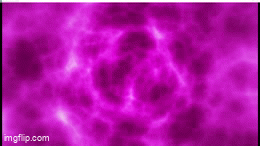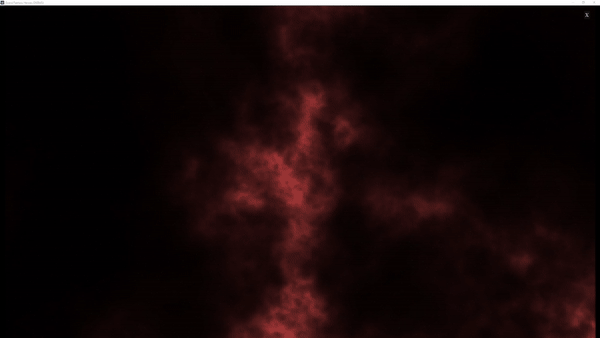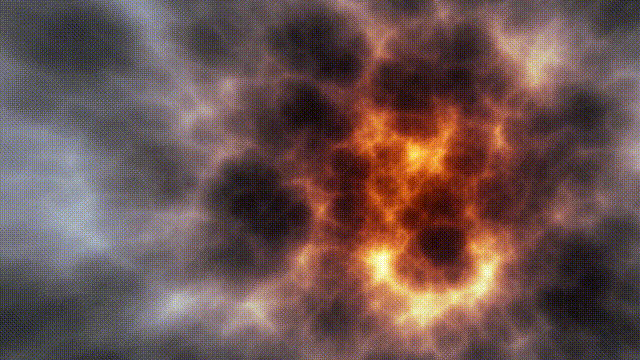Combustible Voronoi with Parameters
All Credit to RayL019, I just added some parameters
Shader code
shader_type canvas_item;
#define iTime TIME
#define iResolution 1.0/SCREEN_PIXEL_SIZE
#define fragColor COLOR
#define fragCoord FRAGCOORD
uniform float kelvin : hint_range(0.0, 10000.0) = 1000.0;
uniform float red_colour: hint_range(0.0, 24.0, 0.1) = 7.4;
uniform float green_colour: hint_range(0.0, 24.0, 0.1) = 5.6;
uniform float blue_colour: hint_range(0.0, 24.0, 0.1) = 4.4;
uniform float time_factor: hint_range(0.0, 3.0, 0.01) = 1.5;
uniform bool move = false;
uniform float resolution: hint_range(0.01, 3.0, 0.01) = 0.4;
uniform float sin_roll: hint_range(0.0, 1.0, 0.01) = 0.25;
uniform float cos_roll: hint_range(0.0, 1.0, 0.01) = 0.25;
uniform float alpha: hint_range(0.0, 1.0, 0.01) = 1.0;
/*
Combustible Voronoi Layers
--------------------------
The effect itself is nothing new or exciting, just some moving 3D Voronoi layering.
However, the fire palette might prove useful to some.
*/
// This is my favorite fire palette. It's trimmed down for shader usage, and is based on an
// article I read at Hugo Elias's site years ago. I'm sure most old people, like me, have
// visited his site at one time or another:
//
// http://freespace.virgin.net/hugo.elias/models/m_ffire.htm
//
vec3 firePalette(float i){
float T = 1400. + kelvin*i; // Temperature range (in Kelvin).
//vec4(0.1,0.1,0.1,1.0
vec3 L = vec3(red_colour, blue_colour, green_colour); // Red, green, blue wavelengths (in hundreds of nanometers).
L = pow(L,vec3(5)) * (exp(1.43876719683e5/(T*L)) - 1.);
return 1. - exp(-5e8/L); // Exposure level. Set to "50." For "70," change the "5" to a "7," etc.
}
/*
vec3 firePalette(float i){
float T = 1400. + 1300.*i; // Temperature range (in Kelvin).
// Hardcode red, green and blue wavelengths (in hundreds of nanometers).
vec3 L = (exp(vec3(19442.7999572, 25692.271372, 32699.2544734)/T) - 1.);
// Exposure level. Set to "50" For "70," change the ".5" to a ".7," etc.
return 1. - exp(-vec3(22532.6051122, 90788.296915, 303184.239775)*2.*.5/L);
}
*/
// Hash function. This particular one probably doesn't disperse things quite as nicely as some
// of the others around, but it's compact, and seems to work.
//
vec3 hash33(vec3 p){
float n = sin(dot(p, vec3(7, 157, 113))); //float n = sin(dot(p, vec3(7, 157, 113)));
return fract(vec3(2097152, 262144, 32768)*n);
}
// 3D Voronoi: Obviously, this is just a rehash of IQ's original.
//
float voronoi(vec3 p){
vec3 b, r, g = floor(p);
p = fract(p); // "p -= g;" works on some GPUs, but not all, for some annoying reason.
// Maximum value: I think outliers could get as high as "3," the squared diagonal length
// of the unit cube, with the mid point being "0.75." Is that right? Either way, for this
// example, the maximum is set to one, which would cover a good part of the range, whilst
// dispensing with the need to clamp the final result.
float d = 1.;
// I've unrolled one of the loops. GPU architecture is a mystery to me, but I'm aware
// they're not fond of nesting, branching, etc. My laptop GPU seems to hate everything,
// including multiple loops. If it were a person, we wouldn't hang out.
for(int j = -1; j <= 1; j++) {
for(int i = -1; i <= 1; i++) {
b = vec3(float(i), float(j), -1);
r = b - p + hash33(g+b);
d = min(d, dot(r,r));
b.z = 0.0;
r = b - p + hash33(g+b);
d = min(d, dot(r,r));
b.z = 1.;
r = b - p + hash33(g+b);
d = min(d, dot(r,r));
}
}
return d; // Range: [0, 1]
}
// Standard fBm function with some time dialation to give a parallax
// kind of effect. In other words, the position and time frequencies
// are changed at different rates from layer to layer.
//
float noiseLayers(in vec3 p) {
// Normally, you'd just add a time vector to "p," and be done with
// it. However, in this instance, time is added seperately so that
// its frequency can be changed at a different rate. "p.z" is thrown
// in there just to distort things a little more.
vec3 t = vec3(0., 0., p.z + iTime*time_factor);
const int iter = 5; // Just five layers is enough.
float tot = 0., sum = 0., amp = 1.; // Total, sum, amplitude.
for (int i = 0; i < iter; i++) {
tot += voronoi(p + t) * amp; // Add the layer to the total.
p *= 2.; // Position multiplied by two.
t *= 1.5; // Time multiplied by less than two.
sum += amp; // Sum of amplitudes.
amp *= .5; // Decrease successive layer amplitude, as normal.
}
return tot/sum; // Range: [0, 1].
}
float rand(vec2 st) {
return fract(sin(dot(st.xy, vec2(12.9898,72.233))) * 53758.5453123);
}
void fragment()
{
// Screen coordinates.
vec2 uv = (UV - 0.5) * vec2( SCREEN_PIXEL_SIZE.y / SCREEN_PIXEL_SIZE.x, 1.0);
// Shifting the central position around, just a little, to simulate a
// moving camera, albeit a pretty lame one.
if (move) {
uv += vec2(sin(iTime*.5)*.25, cos(iTime*.5)*.125);
}
// Constructing the unit ray.
vec3 rd = normalize(vec3(uv.x, uv.y, resolution + 0.1415926535898/8.));
// Rotating the ray about the XY plane, to simulate a rolling camera.
float cs = cos(iTime*cos_roll), si = sin(iTime*sin_roll);
// Apparently "r *= rM" can break in some older browsers.
rd.xy = rd.xy*mat2(vec2(cs, -si), vec2(si, cs));
// Passing a unit ray multiple into the Voronoi layer function, which
// is nothing more than an fBm setup with some time dialation.
float c = noiseLayers(rd*2.);
// Optional: Adding a bit of random noise for a subtle dust effect.
c = max(c + dot(hash33(rd)*2. - 1., vec3(.015)), 0.);
// Coloring:
// Nebula.
c *= sqrt(c)*1.5; // Contrast.
vec3 col = firePalette(c); // Palettization.
//col = mix(col, col.zyx*.1+ c*.9, clamp((1.+rd.x+rd.y)*0.45, 0., 1.)); // Color dispersion.
col = mix(col, col.zyx*.15 + c*.85, min(pow(dot(rd.xy, rd.xy)*1.2, 1.5), 1.)); // Color dispersion.
col = pow(col, vec3(1.25)); // Tweaking the contrast a little.
// The fire palette on its own. Perhaps a little too much fire color.
//c = pow(c*1.33, 1.25);
//vec3 col = firePalette(c);
// Black and white, just to keep the art students happy. :)
//c *= c*1.5;
//vec3 col = vec3(c);
float stars = 0.0;
if (rand(SCREEN_UV.xy / 20.0) > 0.995) //0.996
{
float r = rand(SCREEN_UV.xy);
stars = r * (0.5 * sin(TIME * (r * 2.0) + 1000.0 * r) + 0.5);
}
// Rough gamma correction, and done.
fragColor = (vec4(sqrt(clamp(col + stars, 0., 1.)), 1)) * alpha;
//fragColor.a =(fragColor.r + fragColor.g + fragColor.b) / 3.;
}







